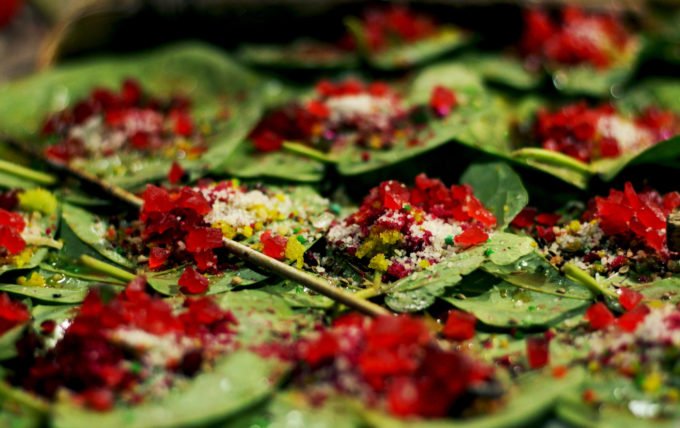
No Paan, No Gain

This week on Roads & Kingdoms, a writer pays homage to her late grandfather—and an ancient culinary tradition in Delhi’s markets. Plus, a conversation with a Nicaraguan cartoonist who says even his most outlandish cartoons are beginning to look like the reality.
This post originally appeared on August 24, 2018, in R&K’s weekly newsletter. Read the archives and subscribe to the newsletter.
Good morning, dear readers.
I’m Michael, and I’m taking over today’s newsletter to talk about a subject near and dear to my heart (and stomach): South Asia’s ubiquitous, tooth-staining stimulant, known as paan.
The first time I ate paan, I swooned. It didn’t help that it was April in Delhi and about 100 degrees outside, or that I’d spent the previous thirty minutes in a stiflingly hot, almost-literal hole-in-the-wall stuffing my face with a punishingly spicy beef and marrow stew called nihari. That kind of voluntary over-stimulation is basically begging for a Victorian-style fainting spell. But also, that first bite of paan was a revelation.
I’d been in India for about a month at that point (I wouldn’t move there until a few years later) and had seen paan stands everywhere. They were always more or less the same: the paanwallah, dressed in white, sitting cross-legged behind packages of paan masala dangling like strips of condoms; the brass pots filled with God knew what; the big vats of betel leaves soaking in water; and the shallow woven baskets covered in red cloth, with the spade-shaped leaves arranged in perfect concentric circles. I was, I’ll admit, afraid to eat it. The horror stories of parasites and amoebic dysentery and all the other half-nonsense slung about eating in India hadn’t stopped me from taking on virtually anything else, but paan, somehow, seemed like a step too far.
Which, of course, was ridiculous. The paan I ate that night was meetha, or sweet, paan, a daintier, more baroque version of the stuff that more hardcore paan addicts, most of them men, chew day and night, staining their teeth and lips and bright rusty red. While a serious paan chewer will ask for his betel leaf stuffed with nothing more than areca nuts and tobacco and perhaps a flourish of fennel seeds, mine came loaded with candied fruit, rose hip jam, coconut and cardamom, and any number of other ingredients that I didn’t have time to identify before they were wrapped in the slick green leaf and slipped into my hand.
That singular combination of flavors and textures, overwhelming and intoxicating and near impossible to put into words, is about as good a metonym for South Asia I know—if also a pretty obvious one. For Aparita Bhandari, who wrote for us about a pilgrimage for paan in her childhood haunts in South and Central Delhi, it’s also a powerful mnemonic for a city slipping into the past. Read her beautiful homage to paan—and her late grandfather who loved paan.
Also on R&K this week, photographer Saumya Khandelwal takes us farther afield into the sprawl of Western Delhi to visit Mayapuri, one of Asia’s largest automotive junkyards. Check out her photo essay on where the cars in India go to die.
On the other side of the globe, Danielle Renwick talked with Pedro Molina, a Nicaraguan cartoonist documenting the horrors of the armed crackdown by the Nicaraguan government against its own citizens, a conflict that has left more than 300 people dead since it started in April. With each day that goes by, Molina told Renwick, even his most outlandish cartoons are beginning to look like the reality in Nicaragua.
Have a good weekend. If you have any thoughts or comments, write to me at michael@roadsandkingdoms.com.
Please follow us on Twitter and Facebook, and encourage your friends and family to subscribe to this newsletter.